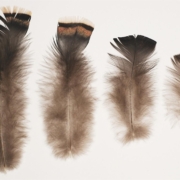Staying warm in the upland southwest: A “supply side” view of turkey feather blanket production
Highlights
- Turkey feather blankets were made by Ancestral Puebloans in the US Southwest.
- Feather blankets and domestic turkeys both appear in early centuries C.E.
- Feathers were wrapped on a plant fiber cord framework.
- A 1.1 m2 blanket used ca. 11,500 feathers from 4 to 10 turkeys and 180 m of cord.
- Sustainable feather supply was likely ensured by collecting feathers from live birds.
Abstract
By the very early C.E. in the U.S. Upland Southwest, blankets or robes relying on turkey feathers as the insulating medium began to replace those made with strips of rabbit fur. Feather blankets would have been important possessions of most members of Ancestral Pueblo communities. Analysis of a 99 X 108 cm feather blanket dating approximately to the 1200s C.E. indicates it required over 180 m of yucca fiber cordage and an estimated 11,550 body feathers. Counts of suitable body feathers from two adult male wild turkey pelts indicated that the prehistoric blanket would have required feathers from 4 to 10 turkeys, depending on the range of feather lengths selected. Blanket feathers were probably most frequently collected from live birds, although natural molts or recently killed birds may have contributed. Further research on the manufacture and use of feather blankets is warranted in the context of their important roles in Ancestral Pueblo material culture and turkey husbandry.
Source: www.sciencedirect.com
William D. Lipe, Shannon Tushingham, Eric Blinman, Laurie Webster, Charles T. LaRue, Aimee Oliver-Bozeman, Jonathan Till



